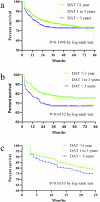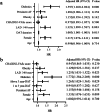Optimal timing for atrial fibrillation patients to undergo catheter ablation
- PMID: 40544216
- PMCID: PMC12182564
- DOI: 10.1038/s43856-025-00960-1
Optimal timing for atrial fibrillation patients to undergo catheter ablation
Abstract
Background: The optimal timing of undergoing catheter ablation for patients with atrial fibrillation (AF) remains uncertain. We aimed to investigate the impact of diagnosis-to-ablation time (DAT) on AF recurrence and major adverse cardiovascular and cerebrovascular events (MACCE) following catheter ablation.
Methods: This study analyzed prospective observational data from a single center, including 2097 participants (59.98 ± 10.57 years, 62.7% male) undergoing AF ablation between January 2016 and December 2020. Patients were stratified by DAT: ≤ 1 year, > 1 to ≤ 3 years, and > 3 years. Cox proportional hazards and logistic regression analyses were used to identify predictors of AF recurrence and MACCE.
Results: During the 46.89 ± 16.46 months follow-up, AF recurs in 512 patients (24.6%). A longer delay per month is significantly associated with a higher recurrence of AF based on multivariable Cox regression analysis [Hazard Ratio (HR) 1.003 (95% CI: 1.001-1.005), p = 0.015]. This association remains consistent in patients with persistent AF (HR compared to DAT ≤ 1 year: 1.548 [95% CI: 1.139-2.102], p = 0.016), but not in those with paroxysmal AF. Left atrial diameter ≥40 mm and female are identified as independent predictors of AF recurrence. The overall impact of DAT on MACCE occurrence is not significant, with age and vascular disease being independent predictors.
Conclusions: Early catheter ablation is preferable for maintaining sinus rhythm, particularly in persistent AF. However, DAT dose not influence the incidence of MACCE. These findings endorse the paradigm shift towards early ablation.
Plain language summary
For patients with atrial fibrillation (AF), a common type of irregular heartbeat, understanding the ideal time to perform catheter ablation, a minimally invasive treatment that uses energy to correct abnormal heart rhythms, is key. In this study, we followed over 2000 patients with AF for about 4 years to see how timing affected treatment success. Findings show patients who had catheter ablation within 3 years of diagnosis were less likely to have their AF return, especially those with long-lasting AF. The study also found women and patients with larger left atrial chambers of the heart had higher risks of their AF returning. These findings suggest earlier catheter ablation helps maintain a normal heart rhythm and can help doctors and patients make more informed decisions about treatment timing.
© 2025. The Author(s).
Conflict of interest statement
Competing interests: The authors declare no competing interests.
Figures



Similar articles
-
Intravenous magnesium sulphate and sotalol for prevention of atrial fibrillation after coronary artery bypass surgery: a systematic review and economic evaluation.Health Technol Assess. 2008 Jun;12(28):iii-iv, ix-95. doi: 10.3310/hta12280. Health Technol Assess. 2008. PMID: 18547499
-
Curative catheter ablation in atrial fibrillation and typical atrial flutter: systematic review and economic evaluation.Health Technol Assess. 2008 Nov;12(34):iii-iv, xi-xiii, 1-198. doi: 10.3310/hta12340. Health Technol Assess. 2008. PMID: 19036232
-
Impact of catheter ablation timing according to duration of atrial fibrillation history on arrhythmia recurrences and clinical outcomes: a meta-analysis.Europace. 2025 Jun 3;27(6):euaf110. doi: 10.1093/europace/euaf110. Europace. 2025. PMID: 40435338 Free PMC article.
-
Interrupted versus uninterrupted anticoagulation therapy for catheter ablation in adults with arrhythmias.Cochrane Database Syst Rev. 2021 Oct 21;10(10):CD013504. doi: 10.1002/14651858.CD013504.pub2. Cochrane Database Syst Rev. 2021. PMID: 34674223 Free PMC article.
-
A rapid and systematic review of the clinical effectiveness and cost-effectiveness of paclitaxel, docetaxel, gemcitabine and vinorelbine in non-small-cell lung cancer.Health Technol Assess. 2001;5(32):1-195. doi: 10.3310/hta5320. Health Technol Assess. 2001. PMID: 12065068
References
-
- Joglar, J. A. et al. 2023 ACC/AHA/ACCP/HRS guideline for the diagnosis and management of atrial fibrillation: a report of the American College of Cardiology/American Heart Association Joint Committee on Clinical Practice Guidelines. Circulation, 10.1161/CIR.0000000000001193 (2023).
-
- Hindricks, G. et al. 2020 ESC Guidelines for the diagnosis and management of atrial fibrillation developed in collaboration with the European Association for Cardio-Thoracic Surgery (EACTS): the task force for the diagnosis and management of atrial fibrillation of the European Society of Cardiology (ESC) developed with the special contribution of the European Heart Rhythm Association (EHRA) of the ESC. Eur. Heart J.42, 373–498 (2021). - PubMed
-
- Kirchhof, P. et al. 2016 ESC Guidelines for the management of atrial fibrillation developed in collaboration with EACTS. Europace18, 1609–1678 (2016). - PubMed
-
- Marrouche, N. F. et al. Catheter ablation for atrial fibrillation with heart failure. N. Engl. J. Med.378, 417–427 (2018). - PubMed
Grants and funding
LinkOut - more resources
Full Text Sources

